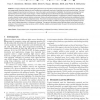Free Online Productivity Tools
i2Speak
i2Symbol
i2OCR
iTex2Img
iWeb2Print
iWeb2Shot
i2Type
iPdf2Split
iPdf2Merge
i2Bopomofo
i2Arabic
i2Style
i2Image
i2PDF
iLatex2Rtf
Sci2ools
PAMI
2007
2007
Multiplexing for Optimal Lighting
—Imaging of objects under variable lighting directions is an important and frequent practice in computer vision, machine vision, and image-based rendering. Methods for such imaging have traditionally used only a single light source per acquired image. They may result in images that are too dark and noisy, e.g., due to the need to avoid saturation of highlights. We introduce an approach that can significantly improve the quality of such images, in which multiple light sources illuminate the object simultaneously from different directions.Theseillumination-multiplexed framesarethen computationally demultiplexed.The approachis usefulforimaging dimobjects, as well as objects having a specular reflection component. We give the optimal scheme by which lighting should be multiplexed to obtain the highest quality output, for signal-independent noise. The scheme is based on Hadamard codes. The consequences of imperfections such as stray light, saturation, and noisy illumination sources are th...
Related Content
| Added | 27 Dec 2010 |
| Updated | 27 Dec 2010 |
| Type | Journal |
| Year | 2007 |
| Where | PAMI |
| Authors | Yoav Y. Schechner, Shree K. Nayar, Peter N. Belhumeur |
Comments (0)

